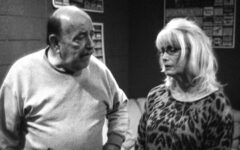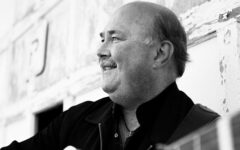
This memoriam to Carl Chatski, who passed away this summer, is a contribution from Shannon Murray, Richard ‘Dick’ Ochs, and other friends of Carl. At the time of his passing we posted a brief note, indicating that we had been unable to find many details about Carl’s life. Mant thanks to his friends for compiling this remembrance.
 Carl Chatski’s untimely death on Thursday, July 24, was mourned by friends, family, musicians and social activists all over the country. He was born Carl Bernard Chatzky on August 15, 1938, in Baltimore. Shortly thereafter, the family moved to the Bronx, NY. Carl graduated from Stuyvesant High School there, and then earned a degree from Johns Hopkins University. He remained in the Baltimore area until moving to Seattle, and had moved to Florida in the year preceding his passing. He is survived by his partner Dr. Shannon Murray of Port St. Lucie, FL; his sister Eleanor Eisenberg of Phoenix AZ/Santa Cruz, CA; and his daughter Heather Chaplin, son Jeremy Chatzky, and granddaughter Mariana Gertrude Chatzky, all of Brooklyn, NY.
Carl Chatski’s untimely death on Thursday, July 24, was mourned by friends, family, musicians and social activists all over the country. He was born Carl Bernard Chatzky on August 15, 1938, in Baltimore. Shortly thereafter, the family moved to the Bronx, NY. Carl graduated from Stuyvesant High School there, and then earned a degree from Johns Hopkins University. He remained in the Baltimore area until moving to Seattle, and had moved to Florida in the year preceding his passing. He is survived by his partner Dr. Shannon Murray of Port St. Lucie, FL; his sister Eleanor Eisenberg of Phoenix AZ/Santa Cruz, CA; and his daughter Heather Chaplin, son Jeremy Chatzky, and granddaughter Mariana Gertrude Chatzky, all of Brooklyn, NY.
Carl was a professional computer systems designer, and a dedicated activist for social justice who donated his time and skills to many non-profit organizations beginning in the mid-1980s. A founder of the Baltimore Information Co-op, Carl set up computer banks for the National Committee in Solidarity with the People of El Salvador (CISPES) in Washington, DC, and the Central America Solidarity Committee (CASC) in Baltimore. He also wrote a program, BIC, to computerize their mailing lists and print mailing labels (previously done manually). To assist the Alternative Press Center in Baltimore in library research, Carl developed a database to index progressive and radical periodicals.
Carl was essential to the founding of the National Security Archive, an independent non-governmental research institute and library at The George Washington University in Washington, DC. He created its first database system to assist in systematically seeking the declassification of secret documents and then indexing them for use by journalists and scholars. “Without Carl’s help during the Iran Contra hearings, we would never have been able to produce a daily update of our massive chronology of events for the press,” said Archive founder Scott Armstrong.
Carl was the Director of Computer Programming for the General Instrument Corporation in Hunt Valley, Maryland, throughout the 1980s. Carl wrote the computer code for the Maryland State Lottery, New York City Welfare Distribution System, and a number of gaming systems. Carl had a futurist vision of how technology could be used in the interest of communities for two-way interactive communication at a time before the advent of the internet as we know it, and was considered a pioneer of the internet revolution. Carl envisioned that cable television could be used in that two-way communication process, and was also active in cable TV issues, advocating a community access channel and community ownership of cable. The latter idea came to fruition in the form of Community Media of Baltimore Channel 75, which broadcasts the Amy Goodman news program.
Carl visited Marshall Eddie Conway in prison, and supported the efforts of the Black Panther Party to secure the release of this leader of the Baltimore branch of the Party. He was also helpful to the Baltimore Welfare Rights organization and designed the first Electronic Welfare Benefits card system for the State of New York. He helped street kids confront the Baltimore Police Department (see The Wire) and helped with a taxicab strike.
For several years, Carl and Shannon helped to organize a chapter of Food Not Bombs to distribute meals for the homeless in Baltimore. Carl also collaborated with Charlie Cook of the National Organization of the Blind to develop a computer-controlled Braille display, with pins that changed position to represent Braille characters based on computer signals.
 A noted instrumentalist on banjo, guitar, bass, and most especially mandolin, Carl was steeped in the vocal and instrumental traditions and repertoire of folk and bluegrass music. He was for a time a housemate of the late Appalachian songwriter and musician Hazel Dickens (whose older brother Arnold named his son after Carl), and they remained close confreres the rest of her life. Carl was a sideman with bluegrass greats Ralph and Carter Stanley during 1959-62, under the stage name Carl Hawkins, and appears with them on a number of recordings including the Smithsonian Folkways Recording Friends of old time music: The folk arrival 1961-1965, released in 2006. Carl also played and performed with Peter Rowan, Mike Munford, John Glik, Del McCoury, Jack Cooke, Lamar Grier and other well known musicians.
A noted instrumentalist on banjo, guitar, bass, and most especially mandolin, Carl was steeped in the vocal and instrumental traditions and repertoire of folk and bluegrass music. He was for a time a housemate of the late Appalachian songwriter and musician Hazel Dickens (whose older brother Arnold named his son after Carl), and they remained close confreres the rest of her life. Carl was a sideman with bluegrass greats Ralph and Carter Stanley during 1959-62, under the stage name Carl Hawkins, and appears with them on a number of recordings including the Smithsonian Folkways Recording Friends of old time music: The folk arrival 1961-1965, released in 2006. Carl also played and performed with Peter Rowan, Mike Munford, John Glik, Del McCoury, Jack Cooke, Lamar Grier and other well known musicians.
Carl was an early mentor to Peter Rowan and David Grisman, and mentored countless other young bluegrass musicians including fiddler Jon Glik and guitarist Harry Orlove. Toward the end of his life he taught a class in bluegrass music for over a decade through the Experimental College at University of Washington, Seattle, where he was a longtime and valued teacher and mentored many instrumentalists and singers.
Carl always liked to sing very old songs and ballads, and especially loved workers and social protest songs. In 2012 he recorded First Will and Testament, a CD with his own arrangements of traditional songs on which a number of longtime friends joined him, which has not been released.
As an early champion and sometime promoter of the New Grass Revival, Carl nurtured an expansive vision for the future of his beloved bluegrass and a reverence for its past, always believing music was not only a joy, but a grand device to unify and uplift the human spirit.







